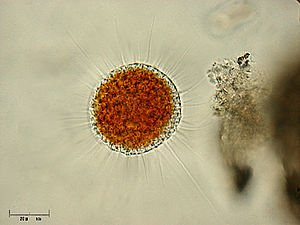Vampyrellidae
| Vampyrellidae | ||||||||||||
|---|---|---|---|---|---|---|---|---|---|---|---|---|

Vampyrella lateritia |
||||||||||||
| Systematics | ||||||||||||
|
||||||||||||
| Scientific name | ||||||||||||
| Vampyrellidae | ||||||||||||
| Braid , 1885 |
The Vampyrellidae are a family of shell-less amoebas from the Cercozoa tribe that was named “ Protozoan of the Year ” by the “German Society for Protozoology” in 2015 .
features
The amoeba of this family have filamentous to narrowing pseudopodia with a fine-grained cytoplasm . The pseudopodia are rarely networked with one another. The cells are mononuclear or polynuclear, the cytoplasm is often colored orange. Food- consuming amoebas alternate with digestive cysts .
The mitochondria have tubular cristae. Dictyosomes occur. Flagella or centrioles are not known. There are helical structures in the cytoplasm, possibly ribosomes . During mitosis , the nuclear envelope remains intact, the spindle apparatus is formed within the cell nucleus.
Occurrence and way of life
The Vampyrellidae occur in fresh and salt water. They nourish themselves by incorporating the cell contents of algae and fungi, which they reach through perforation of the cell walls.
Systematics
Little is known about the relationship of the Vampyrellidae. The few species that have been investigated by molecular genetics form a common clade with many undescribed species that are only known as environmental DNA samples , which is the sister group of the Phytomyxea .
The following genera (with selected species) are added to the family:
- Vampyrella
- Arachnula
- Platyreta
- Lateromyxa
- Theratomyxa
- Gobiella
- Hyalodiscus
- Leptomyxa
- Vampyrelloides : the only genus found in seawater, it lives on algae
supporting documents
- David J. Patterson: The Diversity of Eukaryotes . The American Naturalist, Vol. 65, Supplement, 1999, pp. 96-124.
- David Bass, Ema E.-Y.Chao, Sergey Nikolaev, Akinori Yabuki, Ken-ichiro Ishida, Cédric Berney, Ursula Pakzad, Claudia Wylezich, Thomas Cavalier-Smith: Phylogeny of Novel Naked Filose and Reticulose Cercozoa: Granofilosea cl.n. and Proteomyxidea Revised . Protist, 2008 doi : 10.1016 / j.protis.2008.07.002
Individual evidence
- ↑ Single cell of the year 2015: Vampyrella (Vampiramöben) , last accessed May 31, 2016.